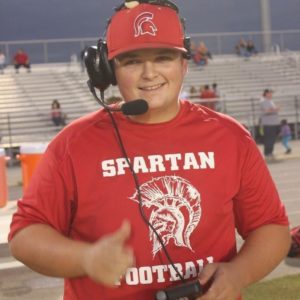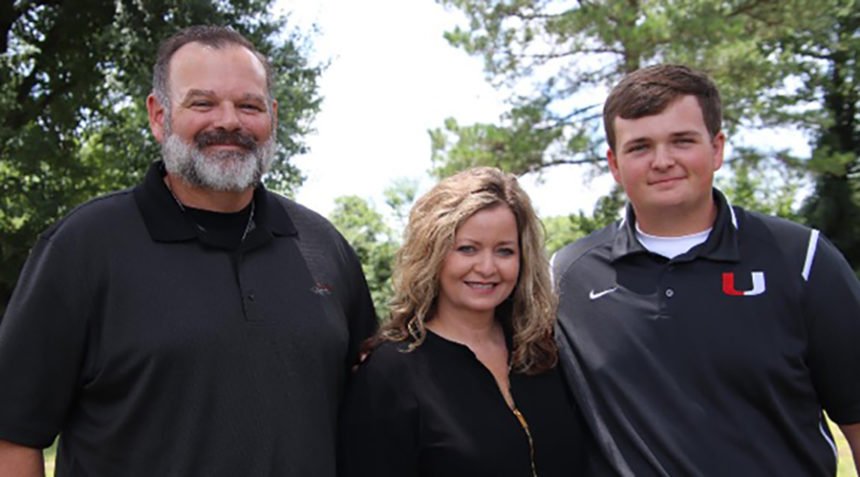It was just another day in gym class for 16-year-old student-athlete Cameron Burley when, suddenly, his heart stopped during a game of basketball. What happened in the crucial seconds after his cardiac arrest saved his life.
Cameron goes to Union High School in the small town of Rose Hill, North Carolina, where his father, Doug Burley, is also a gym teacher and coach. In fact, it was in his dad’s class on May 17 that Cameron started feeling dizzy and fell to the ground. He stood up only to fall again, this time losing consciousness.
“He’s never been sick. He’s been healthy his whole life,” says Cameron’s mother, Ashley Burley. “The sickest he’s ever been is with chickenpox when he was 10 months old.”
Cameron had never passed out before, even during much more vigorous training sessions; he’s played football, basketball and baseball. His father knew something was seriously wrong.
“We got the school nurse and the school principal and started prepping an AED (automated external defibrillator) to use on Cameron,” Mr. Burley says.
The Lifesaving Power of an AED
An AED is a portable electronic device that first diagnoses life-threatening cardiac arrhythmias, or irregular heartbeats, and then recommends whether defibrillation—a shock to the heart—is needed. In Cameron’s case, it was.
“The nurse hooked him up to the AED while I was doing CPR. We shocked him once. Then he took a deep breath and came back to us,” Mr. Burley says.
Mr. Burley believes divine intervention prepared them for that moment and saved Cameron’s life. First, the AED was new to the school. It was acquired by the principal just two months earlier through a grant from the Firehouse Subs Public Safety Foundation. And the nurse who used the AED? It was her first day back on the job after four months of battling cancer.
Getting to the Bottom of a Teenager’s Cardiac Arrest
 The AED was just the beginning of Cameron’s story. After he was revived, he was transported in an ambulance to New Hanover Regional Medical Center in Wilmington, where he spent several hours undergoing tests. That same day he was taken to UNC Medical Center in Chapel Hill for advanced treatment. Over the next few days, Cameron received more tests and screenings to try to determine what caused his heart to stop beating.
The AED was just the beginning of Cameron’s story. After he was revived, he was transported in an ambulance to New Hanover Regional Medical Center in Wilmington, where he spent several hours undergoing tests. That same day he was taken to UNC Medical Center in Chapel Hill for advanced treatment. Over the next few days, Cameron received more tests and screenings to try to determine what caused his heart to stop beating.
Finding out what caused Cameron’s heart to stop was critical to making him well; cardiac arrests are rare in people his age, accounting for about 2,000 deaths a year. In adults, cardiac arrest is the most common form of natural death in the U.S. and can be caused by coronary artery disease.
When the test results came in, Cameron looked healthy. An echocardiogram and cardiac catheterization showed that his heart was working normally and his blood vessels were strong. Cameron and his family are still waiting on results of genetic testing that could reveal an underlying defect.
Because there was no way to tell if Cameron would go into cardiac arrest again, his physicians at UNC recommended he undergo surgery for an implantable cardioverter defibrillator. An ICD is a battery-powered device implanted under the skin that tracks the heart’s rhythm and automatically sends an electric shock through the heart if it detects abnormal beating. Five days after his gym class scare, Cameron went into surgery.
“When the doctors said I needed heart surgery, I figured I would be fine because they knew what was best for me,” Cameron says.
Life After Heart Surgery
Cameron’s surgery went well, and he and his family went home the next day. Two months later, Cameron’s doctor cleared him to start doing some physical activity, such as mowing the lawn. However, the athlete will miss out on at least some sports in his senior year. He can’t play football or basketball, but he might get to play baseball in the spring.
The Burleys are getting used to their new normal. Cameron is taking a positive outlook, even though he has to be careful with physical activity. His parents are still recovering from the trauma of nearly losing their son.
“We’re still a little concerned,” Mr. Burley says. “I still get up at night and go check on Cameron to make sure he’s doing all right.”
Mrs. Burley adds: “Now we’re taking it day by day and saying a lot of prayers while spending as much time together as possible.”
The Burleys stress the importance of having an AED in every public setting, especially schools. It saved Cameron’s life. They hope his story can spread awareness about how important it could be to someone else.
Because an AED provides instructions for the user, anyone can save a life. People interested in learning more about the device and becoming certified to use an AED can take a class through the American Heart Association.
Read other inspiring patient stories like Cameron’s in our UNC Health Talk stories section.

